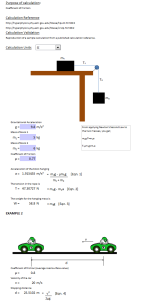Friction Resisting Motion

Description
Purpose of calculation:
Coefficient of Friction
Calculation Reference
http://hyperphysics.phy-astr.gsu.edu/hbase/hpul2.html#c2
http://hyperphysics.phy-astr.gsu.edu/hbase/crstp.html#c2
Calculation Validation
Reproduction of a sample calculation from a published calculation reference.
Calculation Reference
Motion Calculations
Laws of motion
Newtonian Mechanics
Friction is a force that opposes the relative motion or tendency of motion between two surfaces in contact. It plays a crucial role in our everyday lives, providing the resistance necessary for walking, driving, and even holding objects. Frictional forces act parallel to the surfaces in contact and opposite to the direction of the motion or intended motion.
There are two main types of friction:
-
Static friction: This type of friction resists the initiation of motion between two stationary surfaces in contact. Static friction is the force that must be overcome to start an object moving. It adjusts itself up to a maximum value, depending on the applied force and the characteristics of the contact surfaces. The maximum static frictional force is determined by the normal force (perpendicular force between the surfaces) and the coefficient of static friction, represented as F_static = μ_static * N.
-
Kinetic (or dynamic) friction: Once an object starts moving, kinetic friction comes into play. This frictional force acts between the moving surfaces and opposes their relative motion. Kinetic friction is typically lower than the maximum static friction, making it easier to maintain motion once it has started. The kinetic frictional force is determined by the normal force and the coefficient of kinetic friction, represented as F_kinetic = μ_kinetic * N.
Friction depends on two main factors:
-
Material properties: Different materials have different coefficients of friction, depending on their surface characteristics. The coefficient of friction (μ) is a dimensionless number that represents the ratio of the frictional force to the normal force. Higher coefficients of friction indicate greater resistance to motion between the surfaces.
-
Normal force: The normal force (N) is the force acting perpendicular to the surfaces in contact. It is often equal to the weight of the object when dealing with horizontal surfaces. The frictional force between two surfaces is directly proportional to the normal force, meaning that as the normal force increases, so does the frictional force.
Friction can be both beneficial and detrimental, depending on the situation. It is essential for activities like walking or driving, where friction between our shoes or tires and the ground allows us to push off and maintain control. However, friction can also result in energy loss, wear and tear on materials, and reduced efficiency in mechanical systems. Engineers often seek to minimize unwanted friction by using lubricants, smooth surfaces, or alternative materials to reduce the frictional forces and improve performance.
Calculation Preview
Full download access to any calculation is available to users with a paid or awarded subscription (XLC Pro).
Subscriptions are free to contributors to the site, alternatively they can be purchased.
Click here for information on subscriptions.


